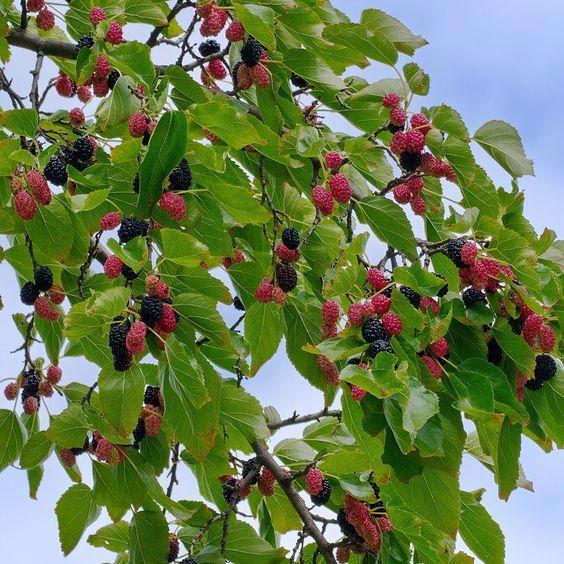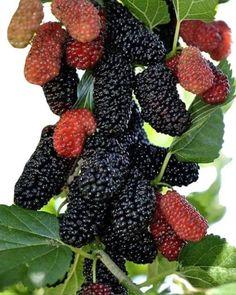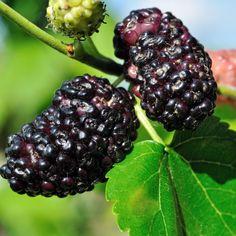Australian Mulberry
Australian mulberry trees, 20-40 feet tall in Zones 9-11, grow rapidly in well-drained soil and full sun. Known for their large and edible fruits, Australian mulberries are enjoyed fresh or in jams.

Habit
Tree
Height
3-5 m
Growth
Fast
Soil
Well-drained loamy soil
Shade
Full Sun
Moisture
Moderate
Edible
Yes
Medicinal
Yes
Origin
Australia
Climatic Condition
Tropical
Temperature (°)
20-30°C
Humidity (%)
70-90%
Potting media
Garden soil
Fertilizers
Organic compost
Watering
Regular watering; keep soil moist
Plant Weight
5-10 kg
Flowering Time
Spring
Soil Ph level
6.0 - 7.5
Water Ph level
6.0 - 7.0
Soil EC
Medium
Yield Per Plant
Edible fruits
NPK ratio
20:20:20
life Span
Perennial
Health Benefits
Fruits are edible and rich in vitamins.
Suggested Grow Media or Potting Mix ?
50% loamy soil, 30% compost, 20% sand
Suggested Fertigation/Fertilizers
Fertilize every 4 weeks with a balanced fertilizer during growing season.
Common Diseases and Remedies
Root knot , sooty mould.
Plants show stunted growth with low moisture in leaves Later yellowing of leaf margin .
Disease occurs due to presence of white flies in mulberry field.
Apply neem oil cake @ 800kg / acre/ year
Maintain proper spacing.
HEALTH BENEFITS
1. Rich in Antioxidants
Mulberries contain anthocyanins, resveratrol, and vitamin C, which help protect cells from oxidative stress and reduce inflammation.
2. Supports Immune System
High vitamin C content boosts immunity, helping the body fight infections and illnesses.
3. Promotes Heart Health
Mulberries contain resveratrol, which may help lower blood pressure and improve circulation. Their fiber and flavonoids also support heart health by reducing cholesterol levels.
4. Aids Digestion
The dietary fiber in mulberries helps regulate digestion, preventing constipation and promoting gut health.
5. Regulates Blood Sugar
Mulberries contain compounds that slow down carbohydrate breakdown, helping manage blood sugar levels—beneficial for people with diabetes.
6. Supports Brain Function
Antioxidants in mulberries protect brain cells from damage, potentially reducing the risk of cognitive decline.
7. Good for Skin Health
Vitamin A, E, and resveratrol in mulberries promote skin hydration, reduce signs of aging, and protect against UV damage.
8. Strengthens Bones
Calcium, iron, and vitamin K in mulberries support bone density and help prevent osteoporosis.
What Is An Australian Mulberry?
Australian mulberry, also known as native mulberry or mulberry, is a type of mulberry found in eastern Australia. It is a small and medium sized tree that can grow up to 10 meters tall. The leaves are large, heart-shaped, and have serrated edges. The fruits of the Australian mulberry are edible, similar to blackberries, and taste sweet and slightly sour. The tree is grown mainly for its fruit, which can be eaten fresh or used to make jams, jellies and desserts.

What Are The Different Types Of Australian Mulberry?
The term "Australian mulberry" can refer to many different plants depending on the context. Here are some examples:
1. Morus australis:
This is the scientific name of the mulberry tree found in eastern Australia. It is a small to medium-sized tree with heart-shaped leaves and edible fruits.
2. Pipturus argenteus:
Also known as mulberry, this plant is found in Australia, New Zealand and the Pacific Islands. It is a small tree or shrub with serrated leaves and small fruits.
3. Streblus brunonianus:
This is another type of mulberry found in Australia and Southeast Asia. It is a small tree with shiny leaves and small fruits.
4. Black mulberry:
Although it is not native to black mulberry, it is also called Australian mulberry. It is a large tree with sweet and juicy dark red fruits.
5. Mulberry:
White mulberries are sometimes called Australian mulberries. It is a large tree with sweet and juicy white or pink fruits.
How To Care Australian Mulberry?
Location
Australian Mulberry (Morus australis) is native to eastern Australia. It is commonly found in tropical rainforests, moist sclerophyll forests and along rivers in New South Wales, Queensland and Victoria. It prefers moist, well-drained soil and tolerates many conditions from full sun to partial shade. The tree is often grown for its fruit and can be found in gardens and orchards in its native country.
Sun light
Australian mulberry trees (Morus australis) generally prefer full sun to partial shade. It can tolerate a lot of light but usually grows in sunny places. Trees will produce more fruit and grow more vigorously in full sun. However, it can still tolerate partial shade, especially in hot weather, and some sun protection will be beneficial. If you plant an Australian mulberry tree, try to provide it with at least 6 hours of direct sunlight each day to see it grow and produce fruit
Soil
Australian Mulberry (Morus australis) prefers moist, well-drained soil rich in organic matter. It tolerates many soil types, including sand, loam and clay, as long as it has good drainage. However, the tree does not grow well in water or poor soil because this can cause root rot and other problems. If you're growing Australian mulberry trees, it's a good idea to amend the soil with compost or other organic matter to increase its fertility and flow. Additionally, mulching around the tree's roots can help retain moisture and reduce weeds.
Hydration
Australian Mulberry (Morus australis) prefers moist soil but can tolerate occasional droughts. However, it is important to water the tree regularly, especially during the dry season, so that the soil always remains moist. Regular watering is generally better than frequent shallow watering because it encourages roots to grow deeper into the soil.
During the first few years after planting, it is important to water the tree regularly to help it establish a strong foundation. When the tree is established, it causes more heat, but it is important to pay attention to the humidity and humidity needed in dry weather, especially in the summer months.

Nourishment
Australian Mulberry trees (Morus australis) benefit from regular pruning to promote good growth and fruit production. Some general tips for supporting Australian mulberry trees:
1. Organic Matter: Add organic matter, such as compost or well-rotted manure, to the soil around the tree. This helps improve soil structure, fertility and moisture retention.
2. Fertilizer: Use a balanced fertilizer such as 10-10-10 or 20-20-20 milk before new growth begins in the spring. Follow the manufacturer's instructions for application.
3. Mulching: Apply a layer of mulch around the tree's roots to help retain moisture, reduce weeds, and add organic matter to the soil as it decomposes.
4. * Water*: Make sure the plant receives adequate water, especially during the dry season. Regular watering is generally better than shallow watering.
5. Pruning: Regular pruning helps maintain the tree's shape, removes dead or diseased branches, and promotes air circulation and sunlight.
Issues
Australian Mulberry (Morus australis) is easy to grow, but like any plant, it can encounter problems. Here are some problems and solutions:
1. Pests: Trees are affected by diseases such as caterpillars, aphids and insects. Inspect trees regularly for disease damage and use appropriate pesticides or natural enemies to control pests.
2. Diseases: Diseases affecting Australian mulberry trees include powdery mildew, leaf spot and root rot. Remember to plant the tree in well-drained soil, not overwater it, and cut off branches to prevent infection.
3. * Nutrient deficiency*: If your tree has yellow leaves or signs of poor growth, it may be suffering from a nutrient deficiency. Use a balanced solution to provide the tree with essential nutrients.
4. Watering Problems: Overwatering or deep watering can cause root rot or poor growth. Make sure the tree gets enough water, especially during the dry season, but avoid wet soil.
5. * Environmental stress*: Bad weather conditions such as rain, ice or storms can cause stress by affecting tree growth and fruit production. Protect trees from these conditions as much as possible.
What are the benefits of Australian mulberry?
Australian Mulberry (Morus australis) has many benefits:1
. Edible Fruit: The tree produces small, sweet, slightly sour fruits that are edible and can be eaten fresh or used in jams, jellies and desserts.
2. Attractive leaves: The tree has large, heart-shaped leaves that are shiny and attractive, making them a beautiful addition to the garden and landscape.
3. Wildlife Attraction: The fruit of the Australian mulberry tree is attractive to birds and other wildlife, making it a valuable addition to the local food supply.
4. Shade and Privacy: This tree can provide shade and privacy when planted in the right location and is a great addition to your outdoor space.
5. Medical Use: In some cultures, the leaves of the Australian mulberry tree are used for medicinal purposes, such as healing the skin and promoting wound healing.
6. Drought Tolerance: Once established, the tree is also drought tolerant and requires very little water to survive.
7. Low Maintenance: Australian mulberry trees are generally low maintenance and easy to grow, making them an excellent choice for beginning gardeners.

FAQs About Growing Australian Mulberry
1. How to process Australian mulberries?
1. Watering: Make sure the tree receives enough water, especially during the dry season. Regular watering is generally better than shallow watering.
2. Fertilization: Use a balanced fertilizer such as 10-10-10 or 20-20-20 milk in the spring before new growth begins. Follow the manufacturer's instructions for application.
3. Pruning: Regular pruning helps maintain the tree's shape, removes dead or diseased branches, and promotes air circulation and sunlight.
4. Pests and Diseases: Monitor trees for pests and diseases and take appropriate precautions if necessary. This may involve the use of organic or chemical control agents, depending on the severity of the disease or condition.
2. What are Australian mulberries used for?
1. Edible Fruit: The tree produces small, sweet, slightly sour fruits that are edible and can be eaten fresh or used in jams, jellies and desserts.
2. Charming leaves: The tree has large leaves, heart-shaped, shiny and attractive leaves, adding beauty to the garden and landscape.
3. Wildlife Attraction: The fruit of the Australian mulberry tree is attractive to birds and other wildlife, making it a valuable addition to the local food supply.
4. Shade and Privacy: This tree can provide shade and privacy when planted in the right location and is a great addition to your outdoor space.
5. Medical Use: In some cultures, the leaves of the Australian mulberry tree are used for medicinal purposes such as healing the skin and promoting wound healing.
3. Can Australian mulberry trees be grown indoors?
The Australian Mulberry Tree (Morus australis) is often grown outdoors in gardens or orchards as it needs full sun and good soil to thrive. But it is possible to grow Australian mulberry trees at home according to the rules:
1.Light
2. Temperature
3. Soil
5. Fertilization
6. Pruning
7. Pests and diseases
4. What is the best pot for growing Australian mulberries?
When choosing a pot to grow an Australian mulberry tree (Morus australis) at home, it is important to consider the size, material and capacity of the pot. Here are some tips:
1. Size
2. Materials
3. Drainage
4. Soil
5. Water
6. Fertilization
7. Pruning
8. Pests and diseases
5. Where can I buy Australian mulberries?
Australian Mulberry Trees (Morus australis) can be purchased from a variety of sources, including nurseries, nurseries, online retailers and specialty fruit stores. Here are some options for purchasing Australian mulberry trees:
1. * Local nurseries and nurseries
2. Online stores
3. Specialty Fruit Tree Suppliers
4. Local Farmers Market
5. Local Fruit Society

